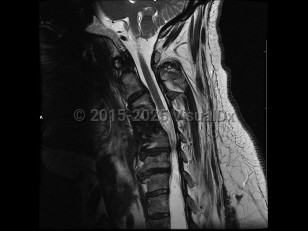Syringomyelia
Alerts and Notices
Important News & Links
Synopsis
Syringomyelia is a cavity or syrinx within the spinal cord that can expand over time. Although the underlying pathophysiology is incompletely understood, syringomyelia is thought to form because of abnormal flow of the cerebrospinal fluid (CSF), and this dysfunctional pressure gradient causes fluid to build up in the spinal cord. Acquired syringomyelia may result from hydrocephalus, infection, inflammation, trauma or spinal cord injury, intramedullary or extramedullary tumors, spinal canal stenosis, vascular malformations, or bony abnormalities. Overall, the prevalence of syringomyelia varies worldwide, ranging from approximately 2-8 per 100 000. Age of onset varies by cause.
Symptoms depend on the location of the lesion; most occur in the cervical region, between C2 and T9. In some cases, patients are asymptomatic, and syringomyelia is an incidental finding on imaging. Cervical syringomyelia typically manifests as early impairment of temperature and pain sensation in a cape-like distribution over the back and arms, and weakness that is greater in the bilateral upper extremities compared with the bilateral lower extremities. There may also be chronic pain. Neurologic examination may be notable for loss of reflexes, light touch, vibration, and joint position sense; weakness and atrophy of the hands; and lower extremity spasticity and hyperreflexia. Bladder, bowel, and erectile dysfunction can occur as late manifestations.
Prognosis depends on the underlying etiology as well as the location and extent of the lesion. However, syringomyelia typically progresses slowly and leads to functional impairment, necessitating surgical intervention. Even after surgical intervention, a treatment-refractory central pain syndrome often persists.
Symptoms depend on the location of the lesion; most occur in the cervical region, between C2 and T9. In some cases, patients are asymptomatic, and syringomyelia is an incidental finding on imaging. Cervical syringomyelia typically manifests as early impairment of temperature and pain sensation in a cape-like distribution over the back and arms, and weakness that is greater in the bilateral upper extremities compared with the bilateral lower extremities. There may also be chronic pain. Neurologic examination may be notable for loss of reflexes, light touch, vibration, and joint position sense; weakness and atrophy of the hands; and lower extremity spasticity and hyperreflexia. Bladder, bowel, and erectile dysfunction can occur as late manifestations.
Prognosis depends on the underlying etiology as well as the location and extent of the lesion. However, syringomyelia typically progresses slowly and leads to functional impairment, necessitating surgical intervention. Even after surgical intervention, a treatment-refractory central pain syndrome often persists.
Codes
ICD10CM:
G95.0 – Syringomyelia and syringobulbia
SNOMEDCT:
111496009 – Syringomyelia
G95.0 – Syringomyelia and syringobulbia
SNOMEDCT:
111496009 – Syringomyelia
Look For
Subscription Required
Diagnostic Pearls
Subscription Required
Differential Diagnosis & Pitfalls

To perform a comparison, select diagnoses from the classic differential
Subscription Required
Best Tests
Subscription Required
Management Pearls
Subscription Required
Therapy
Subscription Required
References
Subscription Required
Last Reviewed:10/20/2019
Last Updated:01/24/2022
Last Updated:01/24/2022
Syringomyelia

